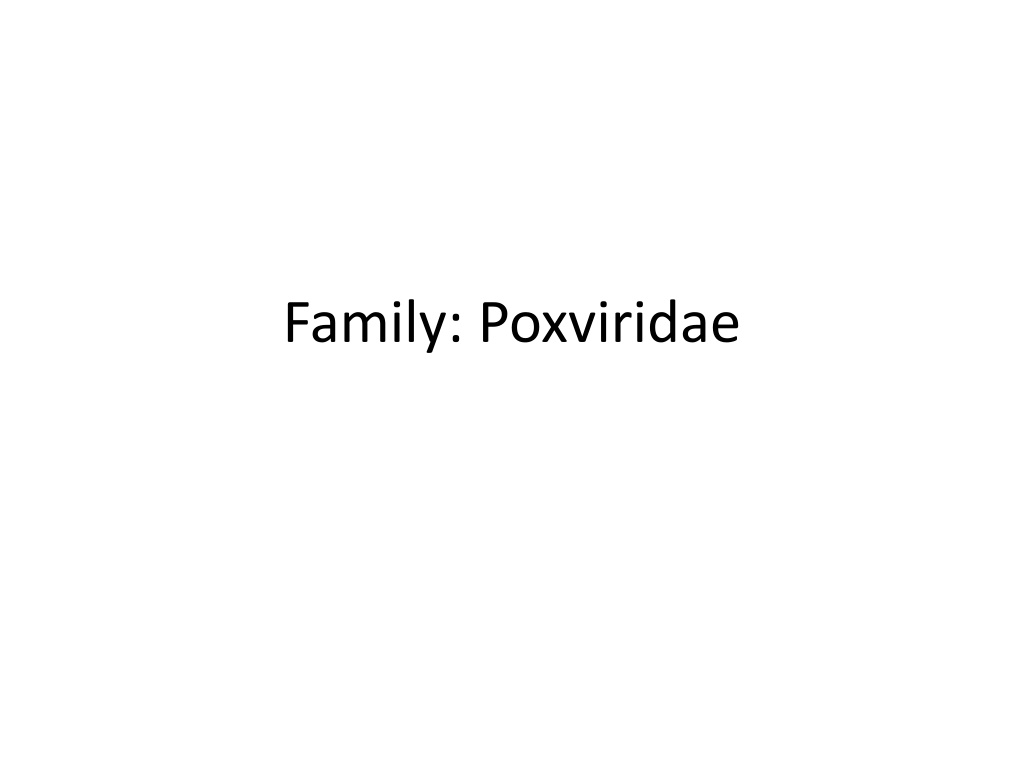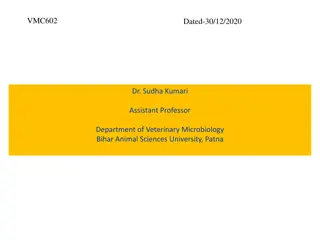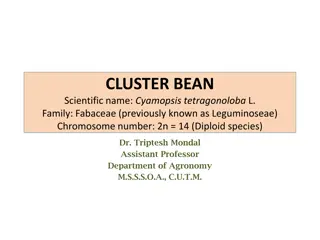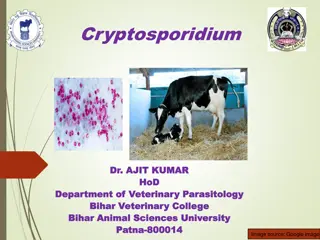Overview of Poxviridae Family: Structure, Classification, and Genus Details
Poxviridae is a family of large viruses known for causing vesicular skin diseases in both animals and humans. This family includes various poxviruses of veterinary and medical importance, each classified under different subfamilies and genera like Orthopoxvirus and Capripoxvirus. The viruses possess complex, enveloped virions with unique properties and a distinctive genome structure, encoding about 200 proteins. Understanding the genetic relatedness and host range of viruses within the same genus is crucial for studying their morphology and replication mechanisms.
Download Presentation

Please find below an Image/Link to download the presentation.
The content on the website is provided AS IS for your information and personal use only. It may not be sold, licensed, or shared on other websites without obtaining consent from the author. Download presentation by click this link. If you encounter any issues during the download, it is possible that the publisher has removed the file from their server.
E N D
Presentation Transcript
'POC' meaning a vesicular skin disease. The members of this family are largest of all viruses Viruses of veterinary and medical importance. All poxviruses have complex, enveloped virions
Classification Poxviridae Chordopoxvirinae (poxviruses of vertebrates) Entomopoxvirinae (poxviruses of insects) Orthopoxvirus Capripoxvirus Suipoxvirus Leporipoxvirus Molluscipoxviru s Yatapoxvirus Avipoxvirus Parapoxvirus
Genus: Orthopoxvirus Variola (smallpox) Humans Vaccinia virus humans, cattlebuffalo, swine, rabbits Cowpox virus cattle, humans, rats, cats, gerbils, large felids, elephants, rhinoceros Camelpox virus Camels Ectromelia virus Mice, voles Monkeypox virus Monkeys. great apes, humangs Genus: Capripoxvirus Sheeppox virus Sheep, Goat Goatpox virus Goats, sheep Lumpyskin disease Cattle, African buffalo Suipoxvirus Swinepox virus Leporipoxvirus Myxoma virus rabbit Molluscipoxvirus Molluscum contagiosum virus (human) Yatapoxvirus Yabapox virus and tanapox virus (Monkeys, Humans) Avipoxvirus Fowlpox virus Parapoxvirus Orf virus, Pseudocowpox virus, Bovine papularstomatitis virus
Members of the same genus are closely related genetically and have a similar morphology and host range
Virion Properties large compared to most other animal viruses with an oval or brick-shaped morphology Complex structure Composed of an outer layer of tubular structures, arranged rather irregularly, giving them a characteristic appearance; outer layer encloses a dumbbell shaped core and two lateral bodies The core contains the viral DNA together with several proteins. Virions that are released from cells by budding have an extra envelope that contains cellular lipids and several virus-specified proteins
Virus Genome Single molecule of linear double-stranded DNA Genomes have the capacity to encode about 200 proteins
The cytoplasm in special viroplasm factories and produce B type inclusion bodies. multiplication takes place in the The cytoplasmic accumulations produce A type inclusion bodies.
Transmission by introduction of virus into small skin abrasions or directly or indirectly from a contaminated environment. respiratory route via droplets from infected animals: eg. orf virus mechanically by biting arthropods: eg. Sheeppox, swinepox, fowlpox, and myxomatosis
Immunity to virus Both CMI and HMI critical CMI facilitate destruction of virus infected cells Neutralizing antibody are important in recovery from infection
Virus Antigen The virus particles are built from more than 30 structural proteins and several viral enzymes, to be used with the nucleic acid synthesis and processing which includes a DNA dependent transcriptase. There are about ten major antigens in the virus particle, one antigen cross reacts with most pox viruses of vertebrates.
Resistance Poxviruses are resistant in the environment under ambient temperatures may survive for many years in dried scabs or other virus-laden material. The pox viruses withstand drying for months and even storage at room temperatures. They are destroyed by moist heat at 60 C within 10 minutes. They are also resistant to many common disinfectants.
Virus Cultivation Most of the pox viruses grow readily in embryonated eggs and produce pocks on the chorioallantoic membrane. They can also be cultivated in cell culture like chicken embryo fibroblasts, bovine kidney, rabbit kidney and HeLa cells.
Cow Pox Virus The cowpox is a benign contagious disease of cattle which is distinct form the viruses of vaccinia and milkers nodule. The disease occurs mostly is milking cows and the lesions restricted to particular areas of animal body like muzzle, udder, testes or scrotum on the one hand and systemic disease with pock covering the whole body on the other hand. The disease is transmitted from affected animals to human beings.
Epidemiology Cow pox is mostly transmitted by direct contact. Passes into the environment through dried pustules from skin and mucous membranes, secretions from eyes, respiratory tract and digestive tract. Enters the body through broken skin or via the mucous membranes of upper respiratory and digestive tract. Indirectly transmitted during milking. Also transmitted to humans, where it causes local affections in the form of pocks on hands, arms and face. Systemic disease with fever, lymphangitis, lymphadenitis, conjuncti- vitis and disseminated pox exanthema may also develop
Clinical Disease Incubation period is 3-7 days. The cattle may show slight fever and anorexia followed by appearance of lesions on teats and udder which pass through all stages of pox infection. lesions are 1-2 cm in diameter and are thick, tenacious and yellow brown to red in colour. Mostly confined to teats and lower parts of udder. In severe cases the lesions may spread to inside of the thighs and rarely to perineum, vulva and mouth. In bulls, the lesions usually appear on the scrotum.
Diagnosis: Based on the appearance of firm dark red circular lesions with raised edges and depressed centres on the teats and udder. Isolation of the virus from lesion serological tests for identification of virus. haemorrhagic pock lesions on the CAM of embryonated eggs is of diagnositc value.
Control: Attenuated strains of cow pox or attenuated vaccinia virus strains is used
Capripox The genome of sheep pox, goatpox and lumpy skin disease of cattle are very closely related. The term 'capripox' is proposed to include the viruses of these pox diseases of ruminants.
Sheep Pox Virus highly contagious and often fatal disease of sheep lesions in generalized cases are associated with haemorrhagic inflammation of respiratory and gastrointestinal mucosa and high mortality
Cultivation: Cultivated in various cell cultures of sheep origin like testes, embryonic kidney and thyroid as well as in goat testes and kidney and bovine testes Produces inclusion bodies in the cytoplasm of cells
Epidemiology: The disease spreads by contact with infected sheep, their aerosals, nasal secretions, saliva or dried scabs. The air borne infection spreads to 20-25 yards. The virus may remain viable in wool for 2 months and on contaminated pens upto 6 months. Mechanical transmission by biting insects may play a part.
Clinical Symptom Incubation period varies from 4-7 days Disease usually causes systemic reaction, with high temperature and eruptions on the cheeks, nostrils, lips, ears, groins, udder and lips of vulva. The lesions begin as macules with slight oedema of surrouding skin. The macules - papules pustules. Pustules mayor may not become vesicles. In more severe cases, lesions in buccal, digestive and respiratory mucosa also develop. The mortality rate may reach upto 80%.
Diagnosis History and the symptoms. confirmation is based on the isolation of virus in susceptible sheep or cell cultures. Detection of antibodies in the recovered animals by neutralization, complement fIxation, gel diffusion and fluorescent antibody tests serum of
Control Ovination: Infected scabs powder in glycerine saline A chinese strain of sheep pox adapted to CAM of chicken embryos In Russia an avirulent strain (K) grown on CAM of chicken embryos is immunity upto 5 months reported to produce
Goat Pox Virus Epizootic disease resembling sheep pox Characterised by fever, mucopurulent nasa! discharge and generalized cutaneous eruptions. In India the disease is of economic significance causing significant losses in goat producing regions. Naturally the virus affects the goats but there are reports that some strains may produce disease among sheep also
Cultivation: The goat pox virus grows readily in cell cultures of lamb kidney, kid kidney, and testis produce CPE similar to sheep pox.
Epidemiology: host specific but some strains are believed to infect sheep as well. The disease spreads by contact with the infected animals or infected fomites. The disease may also be spread mechanically. by insects
Clinical symptom Incubation period of 5-14 days. Small papules appear mostly on the hairless parts of the body like nose, mouth, around the eyes, udder, testes, scrotum, inner aspect of thighs. The subsequently heal in 3-4 weeks. lesions develop into vesicles and crusts and The disease is more common in young animals or in lactating animals. The mortality rate varies from 0 to 50%
Diagnosis and Control Same as Sheep Pox virus Chicken embryo adapted strains are being used in certain countries. Goat pox strains attenuated in cell culture
Lumpy Skin Disease Acute febrile disease of cattle Characterized by eruption of skin nodules of varying sizes. Drop in milk yield and abortions occur among pregnant animals.
Ecthyma (Orf) Virus Orf or Contagious pustular dermatitis or Contagious ecthyma (CE) highly infectious disease of sheep and goats characterised by development of pustular and scabby lesions on muzzle and lips. Incidence among kids and lambs of 4-6 months is very high
Epidemiology Orf is highly contagious among sheep and goats. The transmission is by contact, aerogenic, or virus remaining infectious in the ground in the dried scabs. The virus is indireclty transmitted by way of carcasses or processed meat from latently slaughtered during viraemic phase. infected animals or The virus can also be transmitted to lambs by infected ewes at birth or later. Latently infected sheep and goats are virus reservoirs.
Clinical Symptom Lesions mostly occur on hairless parts of the body, lips, mouth and sometimes udder and interdigital region of the feet. Lesions like papules, pustules and ulcers develop in 34 days. The course of the disease is 3-4 weeks. Cytoplasmic inclusion affected cells. bodies occur in the
Diagnosis and Control Same as other pox viruses live virus vaccine Lambs and kids are vaccinated at 1 month of age and again revaccinated 2-3 months later.
Fowl Pox Virus also known as Avian diphteria disease mainly affects chicken but other poultry like turkeys, guinea fowl, peacocks, pigeons, water fowl, pheasants, canaries and sparrows may be affected avian pox viruses are not related to other mammalian pox viruses cross neutralization among avian pox viruses
Cultivation: The virus grows readily on CAM of developing chicken embryos and produces pock lesions. The virus also grows on fibroblasts and produces intracytoplasmic inclusions (Borrel bodies). chicken embryos
Epidemiology: Affects all ages but is mostly seen in 5-12 months old chickens. Virus is very stable and survives in dried scabs and exudates for many months. Infection occurs through mechanical transmission of the virus to injured skin. Blood sucking arthropods like mosquitoes, ticks or flies may also take part in transmission. Virus may also enter through minor abrasions in the mouth caused by rough feed or through feather follicles and also through injuries to comb, wattles or skin as a result of fighting, pecking, scratching etc.
Clinical Symptom incubation period is 4-10 days. Cutaneous form and Diptheretic form Cutaneous form: mostly found on the comb, wattles, legs, feet, vent and around the eyes. Lesions first appear as white foci which develop rapidly into nodules. The lesions may coalesce and become rough and dark brown. Diptheritic form: Slightly elevated membranes of pharynx and larynx resulting respiratory distress white opaque nodules develop into mucous
Diagnosis Same as other pox viruses Fowl pox vaccine: contains live attenuated virus of chicken embryos or tissue culture origin can be given to birds by feather follicle or wing web method. The age at vaccination by cutaneous method is 4 to 8 weeks.























